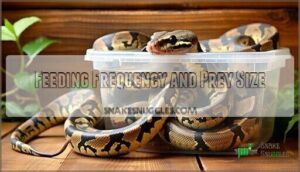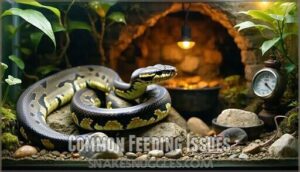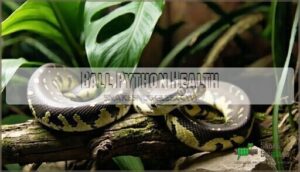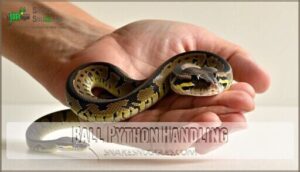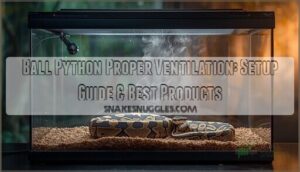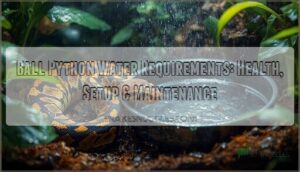This site is supported by our readers. We may earn a commission, at no cost to you, if you purchase through links.
 If you’re considering a ball python as a pet, you’ve picked one of the most beginner-friendly snakes around.
If you’re considering a ball python as a pet, you’ve picked one of the most beginner-friendly snakes around.
These docile reptiles rarely bite, grow to a manageable 3-5 feet, and only eat once every week or two.
You’ll need a 40-gallon tank with proper heating (88-92°F basking spot), humidity around 50-60%, and secure hiding spots.
Ball pythons are notorious for being picky eaters, but captive-bred specimens adapt well to frozen-thawed rodents.
They’re basically the golden retrievers of the snake world – calm, predictable, and surprisingly social.
The secret to their care lies in understanding their natural behaviors and creating the right environment.
Table Of Contents
- Key Takeaways
- Ball Python Overview
- Ball Python Care
- Ball Python Diet
- Ball Python Health
- Ball Python Handling
- Frequently Asked Questions (FAQs)
- Are ball python snakes harmful?
- Are ball python snakes aggressive?
- Are ball pythons the most powerful snake?
- Is a ball python snake friendly?
- Can I have a ball python as a pet?
- How much does a ball python snake cost?
- Can a ball python be a good pet?
- What are the cons of owning a ball python?
- Do ball pythons like to be cuddled?
- Do pet ball pythons like to be held?
- Conclusion
Key Takeaways
- You’ll need a proper setup first – Get a 40-gallon tank with heating that maintains 88-92°F basking spots, 50-60% humidity, and secure hiding places on both the warm and cool sides.
- They’re beginner-friendly but require commitment – Ball pythons live 20-30 years, rarely bite, and only eat every 1-2 weeks, making them manageable for first-time snake owners.
- Feeding can be tricky but manageable – Choose captive-bred snakes that adapt well to frozen-thawed rodents, and do not panic if they refuse food occasionally, since it’s normal behavior.
- Health monitoring prevents major issues – Watch for respiratory problems, maintain proper temperatures and humidity, and schedule annual vet checkups to catch problems early.
Ball Python Overview
You’re about to discover why ball pythons rank as the most beginner-friendly snake species, with their docile temperament and straightforward care requirements making them perfect first reptile pets.
These African natives curl into defensive balls when stressed, but captive-bred specimens adapt beautifully to home environments with proper setup and handling, showcasing their docile nature.
Ball pythons transform from wild warriors into gentle companions through careful captive breeding.
Species Characteristics
The ball python (Python regius) stands out as the perfect beginner snake species, combining a docile temperament with manageable size requirements.
You’ll find these nocturnal creatures surprisingly calm and easy to handle, making them ideal first pets.
- Docile temperament: Ball pythons rarely bite and prefer defensive coiling over aggression
- Average lifespan: 20-30 years with proper care, some reaching 40+ years
- Size variation: Females grow 3-5 feet, males stay smaller at 2-3 feet
- Color morphs: Over 6,500 varieties available, from standard browns to exotic patterns
Natural Habitat
Ball pythons originate from central Africa’s grasslands and forests, where they’ve adapted to specific humidity and temperature ranges.
Their African origins explain their natural behaviors like nocturnal hunting and defensive coiling.
Their natural diet consists of small mammals and birds.
Unfortunately, habitat destruction threatens wild populations, though their conservation status remains stable due to successful captive breeding programs worldwide.
Captive-Bred Vs Wild-Caught
When choosing your first pet snake, you’ll face a vital decision between captive-bred and wild-caught ball pythons.
Captive-bred ball pythons make healthier, calmer pets than their wild-caught counterparts.
Captive-bred specimens offer superior docility differences, requiring minimal acclimation challenges compared to their wild-caught counterparts.
Wild-caught snakes carry significant parasite risks and face severe acclimation stress that can last months.
Beyond ethical concerns, choosing captive-bred supports conservation impact by reducing demand for wild populations.
These snakes are available due to captive breeding efforts that began in the 1990s.
Ball Python Care
Creating a proper habitat for your ball python is essential for their health and happiness.
You’ll need to focus on three key areas: enclosure size, temperature control, and substrate selection to guarantee your snake thrives in captivity.
Enclosure Size and Setup
Your ball python’s home needs careful planning to guarantee comfort and security. Tank dimensions should be 4′ x 2′ x 2′ for adults, with juveniles starting in 20-gallon setups. Proper ball python setup prevents stress and promotes natural behaviors.
Ball pythons also need proper humidity levels of 50%-60% to thrive.
- Glass tank or PVC enclosure with secure, escape-proof lid for safety
- Substrate types like cypress mulch or coconut fiber maintain humidity levels
- Two hiding spots placed on warm and cool sides for thermoregulation
- Water dish large enough for soaking and drinking needs
- Plant benefits include humidity control and environmental enrichment
Temperature and Humidity Control
Your ball python’s comfort depends on precise temperature regulation and humidity control.
Maintain a temperature gradient from 75-80°F on the cool side to 88-92°F in the basking area using heating methods like ceramic heat emitters.
Monitor ball python humidity at 50-60% daily, increasing to 70% during shedding to prevent shedding issues.
Digital thermometers and hygrometers guarantee accurate readings for ideal ball python temperature and humidity levels year-round.
Substrate and Hide Options
Your ball python enclosure setup isn’t complete without proper substrate materials and hide security. Choose cypress mulch, orchid bark, or aspen shavings for ideal moisture retention and cleaning frequency. Avoid cedar substrates containing harmful oils.
Coconut fiber retains moisture and releases it gradually.
- Substrate depth: Maintain 2-3 inches for burrowing and humidity control
- Hide box placement: Position one on each temperature zone for thermal regulation
- Enrichment options: Add artificial plants and branches for behavioral stimulation
- Aesthetical appeal: Select natural-looking materials that complement your ball python substrate choice
Ball Python Diet
Your ball python’s diet is surprisingly simple since these snakes are obligate carnivores that eat whole prey like mice and rats.
Getting the feeding schedule and prey size right will keep your snake healthy and prevent common issues like food refusal that frustrate many new owners, which is why understanding the diet is crucial for maintaining a healthy snake.
Feeding Frequency and Prey Size
Your feeding schedule depends on your snake’s age and size.
Juvenile feeding requires weekly meals, while adult portions come every 1-2 weeks.
Choose prey type matching your ball python’s thickest body section – typically mice for juveniles, feeder rats for adults.
Prekilled prey prevents injury during snake feeding.
Many owners find success using frozen reptile feeders.
Monitor your ball python diet carefully, as refusal reasons include stress, temperature issues, or seasonal changes affecting appetite patterns.
Thawing Frozen Food
Proper thawing guarantees your ball python gets safe, nutritious meals. Never use microwaves or hot water, which create dangerous hot spots and destroy nutrients.
- Refrigerator thawing – Move frozen feeder rats overnight for gradual defrosting
- Room temperature – Leave pinky mice out 2-3 hours before feeding time
- Warm water bath – Submerge sealed prey in lukewarm water for quick results
Room temperature thawing works best for palatability factors. Never refreeze thawed food – bacteria multiply rapidly, risking your snake’s health.
Common Feeding Issues
During your ball python’s life, you’ll likely encounter refusal to eat—it’s normal behavior, not a crisis.
Environmental factors like incorrect temperatures or humidity often trigger feeding strikes. Food size matters; prey larger than your snake’s midsection causes problems. Temperature and humidity are key factors to keep in mind.
| Issue | Cause | Solution |
|---|---|---|
| Refusal to eat | Temperature/humidity off | Check heating/humidity levels |
| Regurgitation | Food too large | Match prey to snake’s width |
| Seasonal fasting | Natural breeding cycle | Monitor weight, don’t panic |
Your feeding schedule affects appetite—juveniles need weekly meals, adults every 10-14 days. Prey type preferences develop over time; some snakes prefer mice over rats. Frozen food works better than live food for safety. Remove uneaten food after 24 hours to prevent spoilage.
Ball Python Health
Your ball python’s health depends on spotting problems early and maintaining proper care conditions.
Regular monitoring and annual vet visits help prevent serious issues like respiratory infections, mouth rot, and feeding problems.
Common Health Issues
Several health problems can derail your ball python’s well-being if you’re not vigilant.
Understanding these common issues helps you spot trouble early and keep your scaly friend thriving.
- Respiratory Infections – Wheezing, open-mouth breathing, and nasal discharge signal serious bacterial or viral infections
- Scale Rot – Damp enclosures cause discolored, blistered belly scales with foul odors
- Mouth Rot – Poor hygiene leads to bloody, pus-filled mouth infections requiring immediate veterinary care
- Parasite Prevention – Snake mites and internal parasites cause anemia, weight loss, and dermatitis. Addressing ball python mite infestations promptly is essential for their health.
- Anorexia Causes – Stress, improper temperatures, or illness trigger dangerous feeding refusals
Signs of Illness
When your ball python isn’t acting like itself, watch for these red flags.
Lethargy and anorexia often signal underlying health problems.
Skin abnormalities like discoloration or unusual bumps warrant attention.
Breathing problems, including wheezing or mouth breathing, indicate respiratory issues.
Regurgitation after feeding suggests digestive distress.
Trust your instincts—healthy snakes show alertness and normal behavior patterns.
Annual Veterinary Check-Ups
Most exotic veterinarians recommend scheduling annual check-ups for your ball python’s health.
These preventative care visits help catch issues early.
When choosing vets, find one with exotic medicine experience.
Vet visit prep includes noting recent feeding, behavior changes, and shedding patterns.
Exam specifics cover weight, body condition, and parasite screening.
Cost breakdown typically ranges $50-150 annually, which is a relatively small price to pay for the health of your ball python.
Ball Python Handling
Proper handling techniques guarantee your ball python stays calm and comfortable during interactions.
You’ll need to support their weight and move slowly to prevent stress, especially during shedding periods when they’re most vulnerable.
Handling Techniques
When handling your ball python, move slowly and support its body weight with both hands.
Read your snake’s body language – tense muscles or hissing means step back. Always lift from underneath, never grab from above.
Keep sessions short, especially for juveniles. Children need adult supervision and proper instruction on safe lifting techniques.
Handle less frequently during shedding periods to prevent stress. Always prioritize your snake’s well-being and safety, using proper instruction to guide your actions.
Shedding and Stress Reduction
During shedding cycles, your ball python becomes vulnerable and stressed. Shedding frequency occurs monthly for juveniles, less often for adults.
Humidity importance increases to 70% during this process. Recognize stress indicators and minimize handling methods:
- Cloudy, blue-tinged eyes signaling pre-shed phase
- Dull, patchy skin preparing to separate
- Hiding more frequently than usual behavior
Enclosure enrichment with rough surfaces helps successful snake shedding completion. Proper humidity control is vital for preventing skin shedding issues to ensure a healthy shedding process and avoid skin shedding issues.
When to Call a Vet
Recognizing vet visit signs can prevent minor issues from becoming serious emergencies.
Contact your veterinarian immediately if you notice respiratory problems like wheezing, open-mouth breathing, or mucus discharge.
Emergency care is essential for snake injuries, severe wounds, or sudden inability to move.
Watch for health alerts including persistent lethargy, weight loss, abnormal swelling, or changes in behavior.
Schedule vet consultation for ball python health concerns rather than waiting—early intervention prevents complications, and it is crucial to address issues like respiratory problems, severe wounds, and sudden inability to ensure the best outcome for your pet’s health.
Frequently Asked Questions (FAQs)
Are ball python snakes harmful?
Ball pythons aren’t harmful to humans.
They’re non-venomous constrictors with docile temperaments.
While they can bite when threatened, their teeth are small and bites rarely cause serious injury.
They’re actually considered one of the safest snake species for beginners.
Are ball python snakes aggressive?
No, ball pythons aren’t aggressive. You’ll find they’re known for their docile temperament, earning them the nickname "gentle giants." They’d rather curl into a defensive ball than bite when threatened.
Are ball pythons the most powerful snake?
Consider this: roughly 70% of constrictors aren’t actually the strongest snakes around.
Ball pythons pack moderate constriction power – they’re built for holding prey, not crushing bones.
Reticulated pythons and anacondas easily outmuscle them in raw strength.
Is a ball python snake friendly?
You’ll find ball pythons surprisingly docile and gentle. They’re naturally calm snakes that rarely bite, making them perfect for beginners. Their defensive move? Curling into a ball rather than striking.
Can I have a ball python as a pet?
Yes, you can keep a ball python as a pet.
They’re beginner-friendly snakes with docile temperaments, living 20-30 years.
You’ll need proper enclosure setup, temperature control, and weekly feedings of frozen mice or rats.
How much does a ball python snake cost?
You’ll pay $20-100 for a captive-bred ball python, depending on morph and breeder.
Basic morphs cost less, while rare color variations reach hundreds.
Captive-bred snakes are healthier investments than wild-caught alternatives.
Can a ball python be a good pet?
Ball pythons make excellent pets for beginners.
They’re docile, low-maintenance, and live 20-30 years.
You’ll need proper heating, humidity, and feeding every 1-2 weeks.
Their calm temperament makes handling enjoyable and stress-free.
What are the cons of owning a ball python?
You’ll face long-term commitment challenges with feeding costs, potential 30+ year lifespan, feeding strikes lasting months, expensive veterinary bills, escape risks, and maintaining precise temperature/humidity requirements.
Do ball pythons like to be cuddled?
Unlike cats or dogs, ball pythons don’t enjoy cuddling.
They’re solitary creatures that tolerate handling rather than seek affection.
You can handle them calmly, but they won’t bond emotionally or desire physical contact for comfort.
Do pet ball pythons like to be held?
Most ball pythons tolerate gentle handling but don’t actively enjoy it like mammals do.
They’re naturally defensive creatures who prefer security over interaction, though they’ll often relax once properly supported and handled calmly.
Conclusion
Research consistently demonstrates that proper environmental conditions directly correlate with ball python longevity and health outcomes.
Your success with a ball python as a pet depends entirely on mastering these fundamentals: consistent temperatures, appropriate humidity levels, and establishing feeding routines.
These snakes aren’t just low-maintenance pets—they’re remarkably resilient when their basic needs are met.
With proper setup and regular monitoring, you’ll enjoy decades of companionship with one of nature’s most adaptable reptiles.
- https://www.riverviewparkandzoo.ca/en/zoo/ball-python.aspx
- https://reptilinks.com/blogs/news/should-i-get-a-ball-python-as-a-pet
- https://www.thesprucepets.com/ball-pythons-1237182
- https://www.reddit.com/r/snakes/comments/tvt1ly/unpopular_opinion_ball_pythons_do_not_make_good/
- https://www.wilbanksreptiles.com/blogs/ball-pythons/common-ball-python-health-issues-and-how-to-prevent-them




